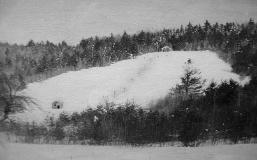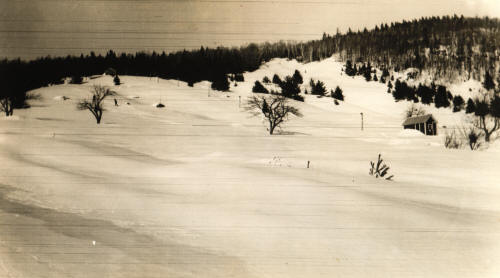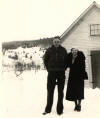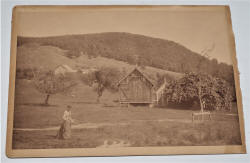
Here's a
photo of a forgotten ski slope in Bartlett Village! Only operating for a short time until the
early 50s, Stanton Slopes was located on the land of Stanton
Farm, which is todays Stillings Grant Housing development.
Find more information from The New England Lost Ski Area Project - Stanton Slopes

This 1940 photo shows both the top and bottom of the rope tow as well as the wide snowcovered hillside. Probably one of the best photos of this site in existence. I think this picture came from Dale Trecarten. Click the picture for a super-size.
In the tracks of ski history
Couple restores old Stanton Slopes lift shack into guest haus
By Tom Eastman
Reporter
—
BARTLETT —
The New England Lost Ski Areas Project tells the stories of New England's gone but not forgotten ski slopes.
Started as a Web site, and now the subject of a recent book by founder Jeremy Davis, a member of the board of directors of the
New England Ski Museum, New England Lost Ski Areas Project gives all ski-history wannabes a glimpse at what once was, when many a ski area dotted the countryside, in most cases with power services by a tractor- or Model T-powered rope tow.
To date, Davis and his partners have profiled 593 lost ski areas in New England and 75 elsewhere in the organization's 11 years on the Web.
One of the areas profiled on the Web site and in the book, “Lost Ski Areas of the White Mountains,” is the old
Mount Stanton Ski Slope that ran in the 1930s and into the 1940s in Bartlett, on the north side of the Saco River, at what is now the Stillings Grant subdivision.
Part of its claim to fame is that a young skier named Pete Seibert
(1924-2002), a Massachusetts native who went on to develop the
Vail ski resort in Colorado, skied there as a kid growing up in Bartlett. Seibert was born on Aug. 7, 1924, in
Sharon, Mass. He spent much of his youth in the White Mountains of New Hampshire, where he practiced with Austrian instructors who had left Europe as war seemed imminent. By 15, he was winning races.
According to Jeff Leich of the New England Ski Museum, Seibert's father arrived in town in the 1930s to serve as a civil engineer with the
Civilian Conservation Corps as they performed forestry projects in the
Bear Mountain area, and the family rented the Stanton farm.
As Leich wrote in an article for the ski museum, “Sketches of Bartlett Ski History,” Seibert — a member of the
U.S. Ski Hall of Fame — recounted his early Bartlett skiing years in his autobiography that “we probably lived in one of the first ski-in/ski-out homes in the U.S."
A few years later, Seibert joined the U.S. Army's 10th Mountain Division, and was seriously wounded in Italy.
After the war he settled in Colorado, where he worked for the
Aspen Ski Patrol and qualified for the 1950 U.S. Ski Team — all this after having been told by doctors he might never ski again.
He worked in the ski business, and remained intent on finding a mountain on which to start a resort that would combine fine skiing with a European style village.
“Anyone who has visited Vail knows how well one-time Bartlett boy Pete Seibert succeeded in realizing his vision,” writes Leich, who resides in North Conway.
• • •
It's a long way from Bartlett to Vail, but on a recent blustery but sunny Saturday morning, Leich and I accepted an invitation to visit the old slope site where the young Seibert got his start.
Through the go-between work of local ski history buff (and award-winning bartender)
Jeff Grdinich of the White Mountain Cider Company Restaurant of Glen, we were invited by landowners
Deb and Dan Holland of Massachusetts to visit the site.
They had bought the lot from developer Joe Berry at Stillings Grant, which includes parts of the old Stanton Slope.
The Hollands said they had sold their timeshare at the Attitash Grand Summit Resort, and, through Berry's input, had used the proceeds to buy the lot.
The Hollands intend to build a home eventually on the lot, but until they do, they have come up with an interim plan/ They hired local contractor
Jon Hill of Fryeburg, Maine, who last fall transformed the rotted old lift shack at the top of the slope into a handsome, free-standing guest haus.
They don't plow the 200-yard drive to their renovated haus in winter, so on that blustery Saturday, Leich and I made the short trek up to the haus, where the Hollands awaited on the porch which looks west out to Attitash and Bear Mountain.
Outside lay the old engine that had once powered the lift.
“I'd like to get that restored some day,” said Holland, who works in the banking industry, and who — like his wife, a retired nurse — is a longtime Attitash skier and cross-country enthusiast. They have been coming to Mount Washington Valley to ski with their four now-grown children for years.
Once at the haus, we were invited inside. The former lift shack is now a cozy one-room mountain getaway, with pine walls, expansive windows and a gas stove. Kerosene lanterns provide the only illumination.
There is no kitchen or bathroom — hence, they frequent local establishments, and take their showers at the Attitash Mountain Village sports club across from Attitash. “We have breakfast at Bart's [Deli], and we usually have dinner at White Mountain Cider Company,” said Dan.
“[Realtor] Rich Samia told us there was one lot with an old ski shack on it, that there used to be a ski slope on it. So, we went to the NELSAP Web site, learned some of the history, and Joe [Berry] drove us up here so we could have a look. We said this should be saved, because there's a lot of history here and we want it to be saved. We came up here, saw the views, and it's just beautiful — so here we are,” said Dan.
Samia introduced them to Jon Hill, the Fryeburg carpenter.
“We really like Jon — I think he has a real feel for what we were trying to do. He used a lot of the old materials; he used the rough-saw wood to keep it looking like the way it was built,” said Dan.
Due to the site's relative isolation, Hill had to haul a generator on his pickup truck to the site to power his tools.
“It was quite a project for him. He did it last fall for us,” said Dan.
In making the transformation, the ever-arty and resourceful Hill added a new floor and insulation as well as new rafters. The rustic character of the old shack shines through. “There used to be a woodstove over on this side, and where it came through the roof, water had gotten in so that wall had collapsed, so he had to replace that wall, but he used wood that was pretty close to what the old wood was,” said Dan.
The night before, the haus interior temperature was quite cold when they arrived, but by morning, “It was 54. Then once the sun came up, it heated up — and now it's 70 again. But it takes awhile because the building is so cold, it takes a while to heat the wood up. It will stay like this, a little cabin, and some day the grandkids will come in here and camp,” said Dan.
The interior is pleasingly decorated, showing off the ambience of an Old Towne wooden canoe. Showing their love for ski history, one wall of the couple's renovated shack shows a framed painting of a vintage 1940s couple skiing. “We got that at Zeb's,” said Debbie.
She and Dan were very enthralled when we two visiting ski historians told them that the inspiration for the “skiing couple” painting is a 1940s black and white photo taken of the late Toni Matt and Paula Kann, legendary Austrian skiers who made Cranmore their home after coming to America. (Matt won the legendary 1939 Mount Washington Inferno by schussing the headwall in Tuckerman Ravine, and Kann was a member of the 1948 Olympic team who later married Swiss ski instructor Paul Valar of Franconia.)
“Well, that's why we invited you guys up here!” laughed Dan.
They say they will use the guest haus as an adjunct to their home when they build it.
• • •
From there, our party of four trekked back down the hill, and drove on the development's access road to the bottom of the hill that once was Stanton Slope.
At the bottom of the slope, they led us to the old ski ticket shack. Yours truly had visited it some 20 years before, and I was thrilled to see that it has stood the ravages of time — but just barely. It wasn't in good repair 20 years ago, and it certainly is leaning some now. It looks like the playful houses at Story Land, the difference being that those leaning structures at Story Land were built that way.
The shack is not located on the Hollands' property, but like their haus, they would love to see it somehow preserved.
“This is pretty much what we started with with our shack,” laughed Debbie, as she crawled through the trees that have grown up at the entrance way to the shack. “Jon did an amazing job for us, he really did,”
she added, comparing the old ticket shack to their now renovated ski haus.
Broken bottles littered the wooden floor of the open-windowed shack.
As we stood at the shack and gazed uphill past a new home in the development, we could make out the Hollands' ski haus peaking above the trees in the distance.
“It was a pretty good drop, I'd say,” said the ski museum's Leich, saying he had checked the NELSAP Web site prior to coming over for the visit that day.
• • •
The Web site contains the following information:
“Stanton Slopes: Before 1938-Late 1940s: Stanton Slopes, located about a half-mile east of Bartlett, was a small ski area, of which not too much is known. In 1938, the ski area had an 800-foot tow which served a 100-foot drop (1938 N.H. Winter Sports Guide). According to the late 1940's World Ski Book provided by Wayne Silver, the area had grown to include "a 1,200-foot tow which serves the 30 acres of open terrain suitable for all grades on a 300-foot vertical drop known as Stanton Slopes."
No other listings appeared after the late 1940s, so “it had probably closed by then,” writes Davis.
The Web site contains some anecdotal information from current Stillings Grant resident Peter Villaume:
“I happen to live on the hill that the Stanton Slopes was once. It happens to be the ‘common lands’ of Stillings Grant development. On Dec. 11th of 1999 there was a severe wind storm (100 plus-mph micro burst) that tumbled in excess of 1,100 trees in the development. This also opened up the old ski hill with one of the tow buildings showing again.This is a fairly rolling area, and could have been a real challenge to traverse before large packers were readily available.”
• • •
Leich says that young Seibert wrote in his autobiography that when his family moved into Bartlett “there was a rope tow in the side yard” and that he was an Eastern Slope Inn golf caddy. “Apparently he heard Lowell Thomas and Harvey Gibson talking about ski resorts down there, and that's what got him thinking about ski resorts,” related Leich to the Hollands.
Leich recently gave a talk on some of Bartlett's early ski history for the Bartlett Historical Society.
In that presentation and in an article he wrote for the ski museum,
Leich said, “In Bartlett as in many other New England villages in the 1930s, the first significant ski trails were cut by the Civilian Conservation Corps. The CCC cut two trails in Bartlett in the summer of 1933 —
the Maple Villa trail on Bartlett Mountain in Intervale, and the Bear Mountain Trail south of Bartlett village.
The Maple Villa started very near the New England Inn, and was a popular trail with ski train passengers due to its proximity to the Intervale and North Conway railroad stations. It dropped 1900 vertical feet over 2 1/4 miles, and was rated for beginners and intermediates.”
The CCC's Bear Mountain Trail, Leich said, was divided into an upper and lower section by the crossing of the then-new Bear Notch Road.
The upper section was for experts, with a vertical drop of 1,700 feet in less than 1 1/2 miles.
“It became a quiet favorite among the White Mountain ski trails, and became the particular domain of the
Schussverein Ski Club, which ran an invitational race there from 1937 until the war years,” wrote Leich.
Shortly after the 1939 arrival of Austrian skimeister Hannes Schneider in North Conway, he and his instructor
Franz Koessler surveyed the Bear Mountain Trail and recommended that it be rated a Class A race trail. This designation was granted by the Eastern Amateur Ski Association, and meant that the Bear Mountain joined four other New England trails — the Wildcat, Nose Dive, Taft and Thunderbolt — as venues for racing's most severe tests.
Leich shared the following story with the Hollands as they gazed out from their guest haus toward Attitash and Bear Mountain the day of our visit:
The legendary 1939 American Inferno on Mount Washington, he said, had its genesis at the third Schussverein invitational downhill on the Bear Mountain Trail.
Leich said that early ski promoter Alec Bright wrote to the White Mountain National Forest supervisor after visiting the trail on Bear Mountain back in 1939:
"Last week,” Bright wrote, “as we stood on Bear Mountain and viewed the complete snow covered beauty of Mount Washington, there was a hue and cry from the old guard that we must revive the old Hochgebirge Inferno
Race, which means the old down Mount Washington Race from summit to Pinkham Notch.
In a matter of weeks, Leigh related, Bright and his Ski Club Hochgebirge had organized the race that is remembered today for Toni Matt's hair-raising schuss of the Tuckerman Ravine headwall.
So, there was a tie-in after all to the painting of Toni Matt on the wall of the cabin — let alone Stanton Slope and Vail.
To think it all started in Bartlett...
Stanton Slopes
 Here's a
photo of a forgotten ski slope in Bartlett Village! Only operating for a short time until the
early 50s, Stanton Slopes was located on the land of Stanton
Farm, which is todays Stillings Grant Housing development.
Find more information from The New England Lost Ski Area Project - Stanton Slopes
Here's a
photo of a forgotten ski slope in Bartlett Village! Only operating for a short time until the
early 50s, Stanton Slopes was located on the land of Stanton
Farm, which is todays Stillings Grant Housing development.
Find more information from The New England Lost Ski Area Project - Stanton Slopes







